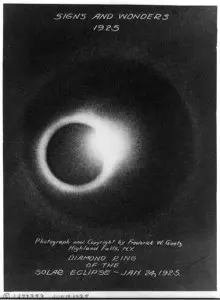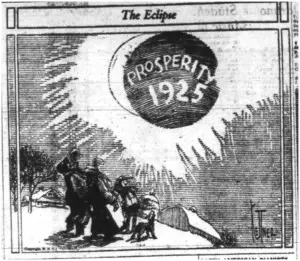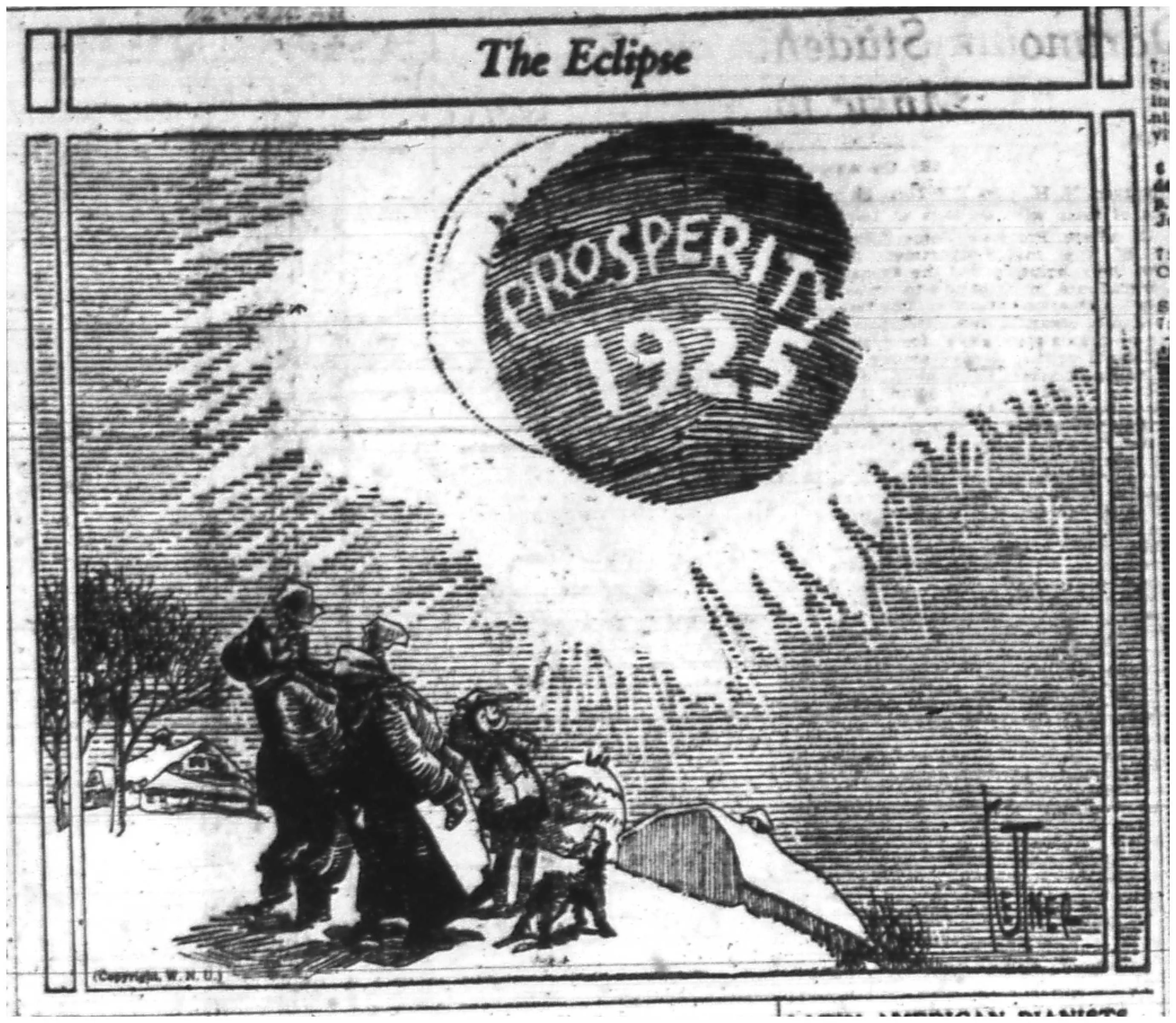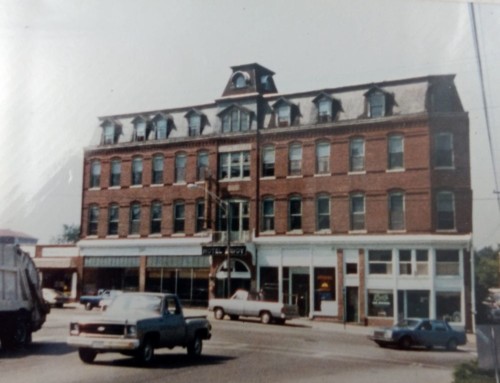For several days in January 1925, Westerly was the host of more than 5,000 visitors who arrived in droves to witness a rare and momentous event, a total solar eclipse. Several days were spent preparing for the thousands who descended upon the town to view the eclipse. Despite the time and effort required to brace for the influx of people, the event lasted a mere two minutes and 32 seconds. [1] Although brief, Westerly’s hospitality and charm left a positive impression on those who chose the town as their viewing destination.
Leading up to the day of the eclipse, New Haven Railroad officials reported that 4,500 round trip tickets had been sold for the train dubbed the “Eclipse Special.” [2] In addition to those who came from Connecticut, New York, and other points south, there were many who arrived on one of the six special trains from Boston, Providence, and Attleboro which ran to and from Westerly in the days prior to the event.[3]
In order to properly coordinate locations, transportation, and other logistics, an eclipse committee was formed by the Westerly Board of Trade (one of the groups which would later form the Chamber of Commerce).[4] The committee was chaired by Frank W. Coy and included other prominent local businessmen including Arthur I. Perry, James M. Pendleton, Arthur M. Nash, and Daniel F. Larkin.[5]
Several landowners in Westerly offered up their properties for viewing, and the committee eventually settled on Foster Farm (now approximately at 85 Beach Street) as the principal location for visitors arriving by train.[6] Due to inclement weather in the days prior to the eclipse, the Highway Department was tasked with clearing snow from a large space on the property. As a means of limiting congestion, cars were not allowed on the farm.[7] Passengers arriving on later trains were taken to a space across from Vose Park (on the Granite Street hill).[8]
Meanwhile, many Westerly residents planned to view the eclipse from Hinckley Hill. William A. Wilcox, who owned ten-acres of land on the hill, opened up his property to those who wanted to see the eclipse.[9] Additionally, the firm of Thorpe and Trainer granted access to a lot of land they owned at Misquamicut Hills, a series of bluffs off of Shore Road, as a potential viewing location.[10]
The committee issued a plea to the people of Westerly to provide vehicles to transport those arriving by train and guests at the hotels downtown.[11] According to the Westerly Sun, rides were provided by “scores of automobiles including buses, jitneys, trucks fitted up especially to carry a number of passengers and private cars loaned by their owners.”[12]

The town was well-protected, as members of local Battery E served as military police, providing assistance to the Westerly Police Department.[15] Local Boy Scout troops were tasked with guiding pedestrians throughout the town and directing traffic.[16] Some viewers began arriving at Vose Park and other areas on Granite Street as early as 7:20 a.m. when they were seated on an old grandstand available for the occasion.[17]
Amenities were provided throughout the morning to accommodate watchers. Due to the cold weather, the town hall, the library, and the Colonial Club were all made available as places where people could warm up.[18] As for food, Harry A. Littlefield informed the eclipse committee that he would be opening his shore dinner house in Watch Hill for those who were in the area.[19] Hot dog and coffee stands were also present at all popular viewing locations.[20]
Several notable individuals made their way to Westerly to see the phenomenon, including Percival P. Baxtor, former Governor of Maine and Alfred C. Lane, professor of Geology at Tufts University, who brought his students down for the event.[21] The most notable name mentioned in the days leading up the event, however, was Thomas Edison. Unfortunately, Edison was unable to come to Westerly, as he could not make the trip due to illness. Edison’s son and daughter made the trip, however, and they were said to have stayed at the Rhode Island Hotel.[22]

The response to Westerly’s hospitality were overwhelmingly positive in the days following the eclipse. Dr. Leonard T. Troland, former President of the American Optical Society, was quoted as saying that the event put Westerly on the map.[25] An article in the Boston Advertiser referred to Westerly as “a royal host.”[26] Much of the praise was given to those who worked to ensure the event ran without issue, and the success was attributed to careful planning and hard work.
For several days in early 1925, Westerly was considered a must-visit destination. The events leading up to and after the solar eclipse of January 24 left an impression on many visitors and provided them with memories which would last a lifetime.
[su_accordion class=””] [su_spoiler title=”Footnotes” open=”no” style=”default” icon=”plus” anchor=”” class=””]
- TOTAL SOLAR ECLIPSE OF 1925 JANUARY 24, NASA Solar Eclipse Database, https://eclipse.gsfc.nasa.gov/SEsearch/SEsearchmap.php?Ecl=19250124.
- “Eclipse Viewers Begin to Arrive” Westerly Sun, 23 January 1925.
- “Eclipse Viewers Begin to Arrive” Westerly Sun, 23 January 1925.
- “Appreciation Widely Shown” Westerly Sun, 25 January 1925.
- “Appreciation Widely Shown” Westerly Sun, 25 January 1925.
- “Business Suspended Till 10 A.M. Saturday for Eclipse” Westerly Sun, 22 January 1925.
- “Business Suspended Till 10 A.M. Saturday for Eclipse” Westerly Sun, 22 January 1925.
- “Business Suspended Till 10 A.M. Saturday for Eclipse” Westerly Sun, 22 January 1925.
- “Eclipse Viewers Begin to Arrive” Westerly Sun, 23 January 1925.
- “Eclipse Viewers Begin to Arrive” Westerly Sun, 23 January 1925.
- “Business Suspended Till 10 A.M. Saturday for Eclipse” Westerly Sun, 22 January 1925.
- “Eclipse Traffic Problem a Big One, But Well Solved” Westerly Sun, 25 January 1925.
- “Eclipse Traffic Problem a Big One, But Well Solved” Westerly Sun, 25 January 1925.
- “Business Suspended Till 10 A.M. Saturday for Eclipse” Westerly Sun, 22 January 1925.
- “Business Suspended Till 10 A.M. Saturday for Eclipse” Westerly Sun, 22 January 1925.
- “Business Suspended Till 10 A.M. Saturday for Eclipse” Westerly Sun, 22 January 1925.
- “See Eclipse In Its Splendor” Westerly Sun, 25 January 1925.
- “Eclipse Viewers Begin to Arrive” Westerly Sun, 23 January 1925.
- “Eclipse Viewers Begin to Arrive” Westerly Sun, 23 January 1925.
- “Eclipse Viewers Begin to Arrive” Westerly Sun, 23 January 1925.
- “Edison’s Son and Daughter Here; Inventor Gives Up Trip” Westerly Sun, 24 January 1925.
- “Edison’s Son and Daughter Here; Inventor Gives Up Trip” Westerly Sun, 24 January 1925.
- TOTAL SOLAR ECLIPSE OF 1925 JANUARY 24, NASA Solar Eclipse Database, https://eclipse.gsfc.nasa.gov/SEsearch/SEsearchmap.php?Ecl=19250124.
- “Radio Tractor Here for Eclipse” Westerly Sun, 22 January 1925.
- “Appreciation Widely Shown” Westerly Sun, 25 January 1925.
- “Appreciation Widely Shown” Westerly Sun, 25 January 1925.
[/su_spoiler] [/su_accordion]






